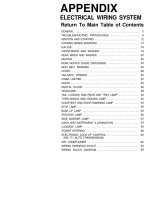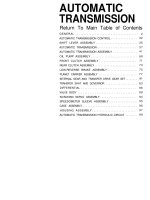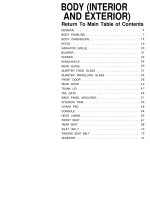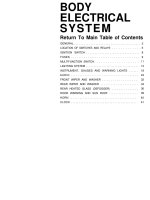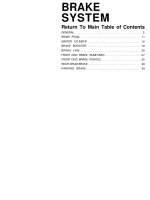Xe ô tô hyundai excel toàn tập hyundai excel - P11
Bạn đang xem bản rút gọn của tài liệu. Xem và tải ngay bản đầy đủ của tài liệu tại đây (654.62 KB, 40 trang )
ENGINE
ELECTRICAL
SYSTEM
Return To Main Table of Contents
GENERAL
.............................................
2
CHARGING SYSTEM
.................................
18
IGNITION SYSTEM
................................... 30
STARTING SYSTEM .................................
35
GENERAL
GENERAL
SPECIFICATIONS
Distributor
U.S.A.
Federal
Manual T/M
U.S.A.
Federal Auto T/M
California
Manual T/M and auto T/M
Type
Advance mechanism
Contact pointless type with electronic control unit
(Electronic ignition system)
Centrifugal type and vacuum type
Firing order
1-3-4-2
Centrifugal advance
- Crankshaft degrees at crankshaft
speed rpm
Initial
0°/1,500
Middle
5°/2,500
Final
16°/6,000
Vacuum advance-Crankshaft
degrees at in. Hg (mmHg)
Initial
0°/-3.15 (-80)
Final
23°/-11.02 (-280)
Idle advance-Crank
degrees at in. Hg (mmHg)
(High-altitude)
2.5°
Air gap
0.03 in. (0.8 mm)
0°/-3.15 (-80)
20°/-14.2 (-360)
2.5°
0.03 in. (0.8 mm)
Ignition Coil
Model No.
E-064 or PN 22C
Primary coil resistance at 20°C (68°F)
1.1 - 1.3
Secondary coil resistance at 20°C (68°F)
11.6 - 15.8
External resistor resistance at 20°C (68°F)
1.2 - 1.6
Insulation resistance by 500V Megger
Over 50
Spark Plug
Factory installed
plug
U.S.A.
RN9YC4
Manufacturer
CHAMPION
Plug gap
(0.039-0.043 in.)
1.0-1.1 mm
Alternate plug
BUR6EA-11
NGK
(0.039-0.043 in.)
1.0-1.1 mm
27-2
GENERAL
Starter Motor
output
No. of pinion teeth
No-load characteristics
(Free-running)
Terminal voltage
Amperage draw
Minimum speed
Pinion gap
A/T Power Steering
M/T
0.9 kW 12V 0.7 kW 12V
8
8
11.5 V 11.5 V
Less than 60A Less than 60A
More than 6,600 rpm
More than 6,500 rpm
0.0197-0.079 in. (0.5-2 mm) 0.0197-0.079 in. (0.5-2 mm)
Alternator
output
Regulator setting
Temperature compensation (Tk)
Voltage regulator type
BOSCH
MELCO
12V - 55A 12V - 60A
14.5v ± 0.1V (20°C) 14.7V ± 0.3V (20°C)
-10 mV/°C ± 2mV/°C
-7 mV/°C ± 3mV/°C
Electronic type
Built-in brush holder
Battery
Type
Ampere hours
Cold cranking
[-17 ± 1°C (0°F)]
Reserve capacity
Life cycle
MF PT 60 (Maintenance-Free battery)
60 Amp hr
400 Amps
90 min
275
NOTES
(a)
CRANKING RATING is the current a battery can deliver for
30
seconds and maintain a voltage of 7.2 or greater
at a specified temperature.
(b) RESERVE CAPACITY RATING is the amount of time a battery can deliver 25A and maintain a minimum
terminal voltage of 10.5 at 26.7°C (80°F)
27-3
GENERAL
CHARGING SYSTEM
Troubles in the charging system may be due to improper fan
belt tension, wiring, connector, a defective electronic voltage
regulator or a bad battery.
What is important in troubleshooting the charging system, is to
determine whether the trouble is due to a rundown or over-
charged battery. Check the batteries condition before checking
alternator. Malfunctions of the IC alternator include the follow-
ing:
Dead battery;
o Faulty (open) IC regulator
o Faulty (broken wire, short circuit) field coil
o Faulty main diode
o Faulty auxiliary diode
o Faulty stator coil
o Faulty brush contact
Over charging: No IC regulator control (short circuit).
In addition to the above, problems with the adjustment voltage
may occur, but these are extremely rare.
Use the following procedure for inspection.
Symptom
Charging warning indicator
does not light with the igni-
tion switch in the “ON” position
and engine off.
Charging warning indicator
does not go out with engine
running. (Battery requires fre-
quent recharging)
Overcharge
Probable cause
Fuse blown
Light burned out
Wiring connection loose
Electronic voltage regulator faulty
Drive belt loose or worn
Battery cables loose, corroded or worn
Fuse blown
Fusible link blown
Electronic voltage regulator or alter-
nator faulty
Wiring faulty
Electronic voltage regulator faulty
Remedy
Check fuses
Replace light
Tighten loose connections
Replace the alternator
Adjust tension or replace drive belt
Repair or replace cable
Replace fuses
Replace fusible link
Check alternator
Repair wiring
Check alternator
27-4
GENERAL
1. Open hood and fit fender covers.
2. Check drive belt tension Fig. 1. Using belt tension gauge it
available.
Alternatively, total free movement measured on the longest
span of the belt should be 0.4 in, (9 mm) applying normal
fingertip pressure. (100N: 22 Ibs.)
Fig. 1
3. Check battery condition.
Refer battery service adjustment procedure.
4. Check charging circuit wiring continuity, Fig. 2.
Disconnect battery ground lead, remove the alternator “L” and
“R” terminals. Refit ground lead and switch on ignition. Con-
nect a 0-20V range voltmeter, between a good ground and
each of the “L” and “R” terminals, in turn. The voltmeter
should read approximately battery voltage in all cases: a zero
volt indicates an open circuit.
A - “L” and “R” terminals
B - Voltmeter
5. Connect output test circuit, Fig. 3.
6. Switch on headlamps, heater blower motor and rear heated
glass, where fitted. Start engine, run it at 3,000 rev/min. Vary
resistance to increase load current. Rated output should be
reached without voltage dropping below 13 volts.
7. Switch off ignition, headlamps, heater blower motor and rear
heated glass and disconnect test circuit.
A - Ammeter
B - Voltmeter
C - Rheostat-Resistor should be 30 amps. rating
8. Connect ‘positive side’ volt drop test circuit and reconnect
alternator “L” and “R” terminal, Fig. 4.
9. Switch on headlamps, start engine, and check volt drop.
Run engine at 3,000 rev/min. If voltage is in excess of 0.5 volt,
this indicates a high resistance on the positive side of the
charging circuit which must be located and rectified.
10. Switch off ignition and headlamps.
Fig. 2
Fig. 3
Fig. 4
27-5
GENERAL
11. Connect ‘negative side’ volt drop test circuit, Fig. 5.
12. Switch on headlamps, start engine and check volt drop.
Run the engine at 3,000 rev/min. Check the voltmeter read-
ing. If the reading is in excess of 0.25 volt, this indicates a high
resistance on the negative side of the charging circuit which
must be located and rectified.
13.
Switch off ignition and headlamps and disconnect test circuit.
14. Connect control voltage test circuit, Fig. 6.
15. Start engine and check regulator voltage.
Run engine at 3,000 rev/min. Note ammeter reading. When
this falls to between 3 and 5 amps, check the voltmeter read-
ing, it should be 13.7 to 14.5 volts. If reading is outside speci-
fied limits, regulator is defective.
16. Switch off ignition and disconnect test circuit.
17. Disconnect battery ground lead.
18. Refit alternator “L” and “R” terminals and refit battery ground
lead.
19. Remove fender covers, close hood.
Handling Precautions
1.
Make sure that alternator, battery, etc., are connected properly.
If battery polarity is reversed, excessive current will flow from
battery to alternator, and damage to diodes or wiring harness
could result.
2.
Using a Megger or other high-voltage tester for the inspection
will cause damage to the diodes.
3. Do not disconnect battery terminals while engine is running.
Surge voltage will be produced which could cause deteriora-
tion of diodes or transistors.
4. When battery is to be quick-charged be sure to disconnect
battery terminals first. If terminals are not disconnected, dam-
age to diodes could result.
5. When a steam cleaner is used, make sure that alternator is not
directly exposed to steam.
Fig 5
Fig. 6
27-6
GENERAL
STARTING SYSTEM
The troubles of starting system may be divided into “Starting
motor does not turn”, “Starting motor turns but engine does not
start” and “It takes some time before engine starts”. When
there is something wrong with starting system, therefore, it is
important to determine which part of starting system is defec-
tive before removing the starter.
Generally, starting difficulty, aside from inoperative starting
motor, is attributable to defective ignition system, fuel system,
battery, electrical wiring, etc. If makeshift corrective steps are
taken without locating the cause, the same trouble will develop
again.
Starter motor does not turn
Check
Turn
ignition switch to “ST”. Does solenoid
make operating sound ?
1. Dead battery
2. Loose terminal B wire
3. Faulty wiring between
battery and
terminal B
Yes
No
Starter motor defective or engine is Is voltage available at S terminal magn-
frozen
etic switch ?
Yes
Starter motor defective
No
Inhibitor switch defective (A/T only)
Defective wiring between battery and
magnetic switch
Refer to page 27-36 and
inspect starter motor
Repair wiring
27-7
GENERAL
Starter motor turns but engine does not start
Does initial engine start occur ?
No
Ignition system or fuel
system defective
Yes
Is starter motor pinion moving away from flywheel teeth too early ?
Yes
No
Starting motor defective
Ignition system or fuel
system defective
Refer to page 27-36 and
inspect starter motor
Overrunning clutch slipping
27-8
GENERAL
27-9
GENERAL
Checking the Voltage Drop between Terminals B and M
To measure the voltage drop between contacts B and M, make
the connections shown in the illustration. If the voltage drop is
1V or more, it may prevent the engine from starting in cold
weather, so replace the switch assembly.
CAUTION
Connect the voltmeter during cranking. If the voltmeter is
connected before the starting motor is operated, it could be
damaged by an inflow of 12V.
NOTES
(a) Disconnect the battery ground cable before doing any
inspection work.
(b) Do not direct a steam cleaner at any of the switches;
water inside the switches could cause them to mal-
function.
IGNITION SYSTEM-DIAGNOSIS
The cause for hard engine starting or malfunction is not always
in ignition system. Defective parts may exist in fuel-system or
the engine itself.
The role of ignition system is to generate sufficient electric
sparks at proper time. To check ignition system, therefore, it is
necessary that spark check and timing measurement are tho-
roughly performed.
For on-vehicle troubleshooting of ignition system, the short cut
is to determine on the basis of symptoms (phenomena) which
circuit is defective, the power supply, primary low tension cir-
cuit or high tension circuit.
For example, when all spark plugs fail to produce sparks, proba-
ble cause is in power supply or primary circuit. If misfiring
occurs only at a specific spark plug, the high tension or secon-
darycircuit is likely to be defective. If misfiring occurs occasion-
ally, loose leads or spark plugs can be suspected.
If good sparks are produced but engine is in poor condition,
probable cause is incorrect timing or defective spark plugs.
27-10
GENERAL
Hard starting
Check battery condition
Check starting system
Check ignition system. See Spark Test
Spark test (When engine can be cranked)
TEST 1
Disconnect high tension cable from the center tower of distributor cap, hold end of cable about 5-10 mm (0.2-0.4 in.)
away from cylinder block of engine, crank engine with starter, and check spark condition.
No spark produced
Spark produced
TEST 2
Check cap, rotor, spark plugs, cable and ignition
With ignition switch at ON position, measure
timing
voltage of (-) terminal of ignition coil
Voltage equal to battery voltage
0 V
Defective wiring between
battery and ignition coil
TEST 3
With key switch at ON position, measure voltage of
(-) terminal of ignition coil
27-11
GENERAL
Poor Low Speed Performance
(Backfiring or hard starting
occurs)
Poor Acceleration
(Poor high speed performance
Insufficient output Engine
stalls on acceleration
Knocking
Distributor improperly Improper spark plug heat
installed
value
Improper octane value of
fuel
Improper ignition timing Improper spark plug gap
Improper spark plug heat
valve
Faulty distributor or igniter
Defective governor advance
mechanism
Faulty advance mechanism
Defective vacuum advance
mechanism
Check ignition timing.
Engine Stalls Occasionally or
Misfiring Occurs Occasionally
Faulty ignition coil
Defective insulation of high
tension cables, cap, rotor
and/or spark plugs
Faulty primary circuit
(Damaged primary cable and
ignition coil or overheated
ignition coil)
27-12
GENERAL
BATTERY-MAINTENANCE FREE TYPE
General Information
1. The maintenance-free battery is, as the name implies, totally
maintenance free and has no removable battery cell caps.
2.
Water never needs to be added to the maintenance-free battery.
3. The battery is completely sealed, except for small vent holes in
the cover.
4. The battery contains a visual test indicator which gives green
signal when an adequate charge level exists, white signal when
charging is required, and red signal when replacement is
required.
Battery Visual Inspection (1)
CHARGE RATE
If the test indicator is white, the battery should be charged.
When the dot appears green, charging should be stopped.
NOTE
If the indicator does not turn to green even after the battery is
charged, the battery should be replaced; do not overcharge.
Battery Visual Inspection (2)
1. Make sure ignition switch is in Off position and all battery feed
accessories are Off.
2. Disconnect battery cables at battery (negative first).
3. Remove battery from vehicle.
CAUTION
Care should be taken in the event battery case is cracked or
leaking to protect hands from the electrolyte. A suitable pair
of rubber gloves (not the household type) should be worn
when removing battery by hand.
4. Inspect battery carrier for damage caused by loss of acid from
battery. If acid damage is present, it will be necessary to clean
area with a solution of clean warm water and baking soda.
Scrub area with a stiff bristle brush and wipe off with a cloth
moistened with ammonia or baking soda in water.
5. Clean top of battery with same solutions as described in Step (4).
6. Inspect battery case and cover for cracks. If cracks are prevent,
battery must be replaced.
7. Clean the battery post with a suitable battery post cleaner.
BATTERY CONDITION INDICATOR
GOOD
UNDER
SHORT
CONDITION CHARGED
OF FLUID
GREEN
WHITE
RED
27-13
GENERAL
8. Clean the inside surfaces of the terminal clamps with a suita-
ble battery terminal cleaning tool. Replace damaged or frayed
cables and broken terminals clamps.
9. Install the battery in vehicle.
10.
Connect cable clamps to battery post, making sure top of clamp
is flush with top of post.
11. Tighten the calmp nut securely.
12. Coat all connections with light mineral grease after tight-
ening.
27-14
GENERAL
IGNITION TIMING
Ignition Timing Adjustment
Adjustment conditions:
Coolant temperature: 80-90°C (170-190°F)
Lamps and all accessories: Off
Transmission: N (Neutral)
1. Connect tachometer and timing light.
2. Start engine and run at curb idle speed.
3. Check basic ignition timing and adjust if necessary.
Basic Ignition Timing
3°BTDC ± 2° : California
5°BTDC ± 2° : Federal
4. To adjust ignition timing, loosen the distributor mounting nut
and turn the distributor housing.
5. After adjustment, securely tighten mounting nut.
SPARK PLUG CABLE TEST
1. Disconnect spark plug cable from spark plug.
When sparkplug cable is pulled out, be sure to pull by the cable
cap. If spark plug is removed by pulling on cable only an open
circuit might result.
2. Hold the spark plug cable about 0.24-0.31 in. (6-8 mm) away
from engine proper (grounding portion such as cylinder block)
and crank engine to verify that sparks are produced.
I
27-15
GENERAL
SPARK PLUG INSPECTION AND TEST
1. Remove the spark plugs from the engine.
2. Visually check the spark plugs for the following and replace if
defective.
(a) Broken insulator.
(b) Worn electrode.
(c) Deposited carbon. Use a plug cleaner for cleaning. Clean
porcelain insulator above shell as well.
(d) Damaged or broken gasket.
(e) Burnt condition of procelain insulator at spark gap.
If black carbon deposit is evident, probable cause is too rich a
fuel mixture or extremely low air intake. Misfiring due to exces-
sive spark gap is also suspected. If insulator is burnt white, too
lean a fuel mixture, excessively advanced ignition timing,
improperly tightened plug, etc. are suspected.
3. Connect the spark plug to the high tension cable, ground outer
electrode (main body), and crank engine. In the atomsphere,
only short sparks are produced because of small discharge gap.
If the sparkplug is good, however, sparks will occur in discharge
gap (between electrodes). In a defective spark plug, no sparks
will occur because of leak of insulation puncture.
4. Check plug gap with plug gap gauge. If it is not within specified
limit, adjust by bending ground electrode.
Make sure that the gap of even a new spark plug is checked
before spark plug is installed to engine.
Spark plug gap . . . . . . . . . . . . . . 0.039-0.043 in. (1.0-1.1 mm)
5. Install the spark plug and tighten to specified torque. If it is
over-torqued, damage to threaded portion of cylinder head
might result.
Spark plug
. . . . . . . . . . . . . . . . . . . . . . . . . . . . . . . . . . . . . . . . . . . . .
20-29 Nm (204-296 kg.cm, 14.75-21.4 Ib.ft)
27-16




